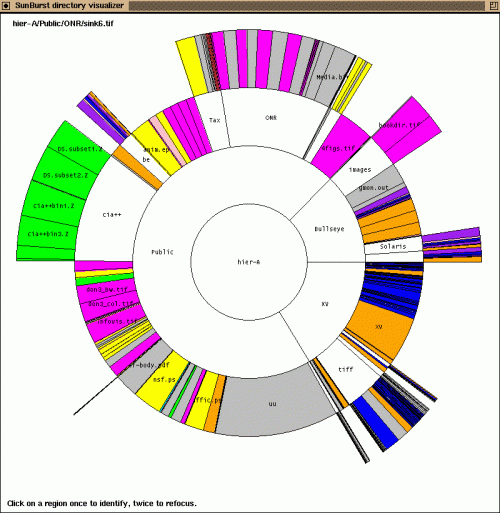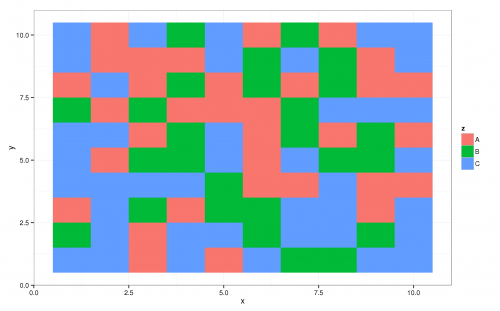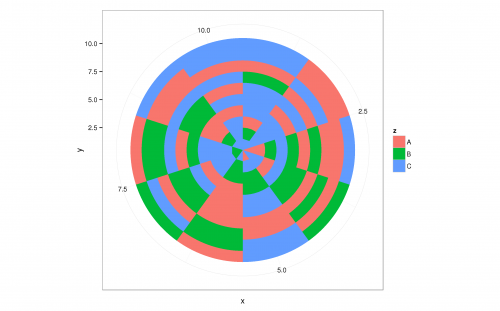Jak zrobić wykres sunburst w R lub Pythonie?
Do tej pory nie udało mi się znaleźć biblioteki R, która mogłaby stworzyć fabułę sunburst jak te autorstwa Johna Staśko. Wie ktoś jak to osiągnąć w R lub Pythonie?

7 answers
Wersja Pythona diagramu sunburst wykorzystującego paski matplotlib w projekcji biegunowej:
import numpy as np
import matplotlib.pyplot as plt
def sunburst(nodes, total=np.pi * 2, offset=0, level=0, ax=None):
ax = ax or plt.subplot(111, projection='polar')
if level == 0 and len(nodes) == 1:
label, value, subnodes = nodes[0]
ax.bar([0], [0.5], [np.pi * 2])
ax.text(0, 0, label, ha='center', va='center')
sunburst(subnodes, total=value, level=level + 1, ax=ax)
elif nodes:
d = np.pi * 2 / total
labels = []
widths = []
local_offset = offset
for label, value, subnodes in nodes:
labels.append(label)
widths.append(value * d)
sunburst(subnodes, total=total, offset=local_offset,
level=level + 1, ax=ax)
local_offset += value
values = np.cumsum([offset * d] + widths[:-1])
heights = [1] * len(nodes)
bottoms = np.zeros(len(nodes)) + level - 0.5
rects = ax.bar(values, heights, widths, bottoms, linewidth=1,
edgecolor='white', align='edge')
for rect, label in zip(rects, labels):
x = rect.get_x() + rect.get_width() / 2
y = rect.get_y() + rect.get_height() / 2
rotation = (90 + (360 - np.degrees(x) % 180)) % 360
ax.text(x, y, label, rotation=rotation, ha='center', va='center')
if level == 0:
ax.set_theta_direction(-1)
ax.set_theta_zero_location('N')
ax.set_axis_off()
Przykład, jak można użyć tej funkcji:
data = [
('/', 100, [
('home', 70, [
('Images', 40, []),
('Videos', 20, []),
('Documents', 5, []),
]),
('usr', 15, [
('src', 6, [
('linux-headers', 4, []),
('virtualbox', 1, []),
]),
('lib', 4, []),
('share', 2, []),
('bin', 1, []),
('local', 1, []),
('include', 1, []),
]),
]),
]
sunburst(data)
Warning: date(): Invalid date.timezone value 'Europe/Kyiv', we selected the timezone 'UTC' for now. in /var/www/agent_stack/data/www/doraprojects.net/template/agent.layouts/content.php on line 54
2017-10-17 13:16:13
Możesz nawet łatwo zbudować interaktywną wersję za pomocą R:
# devtools::install_github("timelyportfolio/sunburstR")
library(sunburstR)
# read in sample visit-sequences.csv data provided in source
# https://gist.github.com/kerryrodden/7090426#file-visit-sequences-csv
sequences <- read.csv(
system.file("examples/visit-sequences.csv",package="sunburstR")
,header=F
,stringsAsFactors = FALSE
)
sunburst(sequences)
...a gdy przesuniesz mysz nad nią, dzieje się magia:
Edit
Oficjalna strona tego pakietu znajduje się tutaj (z wieloma przykładami!): https://github.com/timelyportfolio/sunburstR
Hat Tip dla @ timelyportfolio, który stworzył ten imponujący kawałek kodu!
Warning: date(): Invalid date.timezone value 'Europe/Kyiv', we selected the timezone 'UTC' for now. in /var/www/agent_stack/data/www/doraprojects.net/template/agent.layouts/content.php on line 54
2015-10-01 15:38:34
Możesz utworzyć coś wzdłuż linii wykresu sunburst używając geom_tile z pakietu ggplot2. Najpierw stwórzmy losowe DANE:
require(ggplot2); theme_set(theme_bw())
require(plyr)
dat = data.frame(expand.grid(x = 1:10, y = 1:10),
z = sample(LETTERS[1:3], size = 100, replace = TRUE))
A następnie utworzyć wykres rastrowy. W tym przypadku oś x na wykresie jest sprzężona ze zmienną x W dat, oś y ze zmienną y, a wypełnienie pikseli ze zmienną z. Daje to następujący wykres:
p = ggplot(dat, aes(x = x, y = y, fill = z)) + geom_tile()
print(p)

Pakiet ggplot2 obsługuje wszystkie rodzaje przekształceń współrzędnych, jedna z nich zajmuje jedną oś i rzutuje ją na okrąg, tj. współrzędne biegunowe:
p + coord_polar()

To z grubsza robi to, czego potrzebujesz, teraz możesz dostosować dat, aby uzyskać pożądany rezultat.
Warning: date(): Invalid date.timezone value 'Europe/Kyiv', we selected the timezone 'UTC' for now. in /var/www/agent_stack/data/www/doraprojects.net/template/agent.layouts/content.php on line 54
2012-10-29 07:48:44
Istnieje pakiet o nazwie ggsunburst. Niestety nie jest w CRAN, ale można zainstalować zgodnie z instrukcją na stronie: http://genome.crg.es / ~didac/ggsunburst/ggsunburst.html .
Pozdrawiam,
Warning: date(): Invalid date.timezone value 'Europe/Kyiv', we selected the timezone 'UTC' for now. in /var/www/agent_stack/data/www/doraprojects.net/template/agent.layouts/content.php on line 54
2015-09-22 15:55:16
Jest tylko kilka bibliotek, które znam, które robią to natywnie:
- The Javascript Infovis Toolkit (jit) (przykład ).
- D3.js
- OCaml ' S Simple Plot Tool (SPT).
Żadne z nich nie jest w Pythonie ani R, ale uzyskanie skryptu Pythona / R do zapisu prostego pliku JSON, który może być załadowany przez jedną z bibliotek javascript, powinno być całkiem możliwe.
Warning: date(): Invalid date.timezone value 'Europe/Kyiv', we selected the timezone 'UTC' for now. in /var/www/agent_stack/data/www/doraprojects.net/template/agent.layouts/content.php on line 54
2012-10-17 04:42:48
Oto ggplot2 sunburst z dwiema warstwami.
Podstawową ideą jest po prostu zrobić inny pasek dla każdej warstwy i uczynić pręty szerszymi dla warstw zewnętrznych. Pomieszałem też z osią x, aby upewnić się, że nie ma dziury w środku wewnętrznego wykresu kołowego. W ten sposób można kontrolować wygląd sunburst poprzez zmianę szerokości i wartości osi X.
library(ggplot2)
# make some fake data
df <- data.frame(
'level1'=c('a', 'a', 'a', 'a', 'b', 'b', 'c', 'c', 'c'),
'level2'=c('a1', 'a2', 'a3', 'a4', 'b1', 'b2', 'c1', 'c2', 'c3'),
'value'=c(.025, .05, .027, .005, .012, .014, .1, .03, .18))
# sunburst plot
ggplot(df, aes(y=value)) +
geom_bar(aes(fill=level1, x=0), width=.5, stat='identity') +
geom_bar(aes(fill=level2, x=.25), width=.25, stat='identity') +
coord_polar(theta='y')
Dla kompletności, tutaj jest oczyszczony z ładniejszym formatowaniem i etykietami:
library(data.table)
# compute cumulative sum for outer labels
df <- data.table(df)
df[, cumulative:=cumsum(value)-(value/2)]
# store labels for inner circle
inner_df <- df[, c('level1', 'value'), with=FALSE]
inner_df[, level1_value:=sum(value), by='level1']
inner_df <- unique(text_df[, c('level1', 'level1_value'), with=FALSE])
inner_df[, cumulative:=cumsum(level1_value)]
inner_df[, prev:=shift(cumulative)]
inner_df[is.na(prev), position:=(level1_value/2)]
inner_df[!is.na(prev), position:=(level1_value/2)+prev]
colors <- c('#6a3d9a', '#1F78B4', '#33A02C', '#3F146D', '#56238D', '#855CB1', '#AD8CD0', '#08619A', '#3F8DC0', '#076302', '#1B8416', '#50B74B')
colorNames <- c(unique(as.character(df$level1)), unique(as.character(df$level2)))
names(colors) <- colorNames
ggplot(df, aes(y=value, x='')) +
geom_bar(aes(fill=level2, x=.25), width=.25, stat='identity') +
geom_bar(aes(fill=level1, x=0), width=.5, stat='identity') +
geom_text(data=inner_df, aes(label=level1, x=.05, y=position)) +
coord_polar(theta='y') +
scale_fill_manual('', values=colors) +
theme_minimal() +
guides(fill=guide_legend(ncol=1)) +
labs(title='') +
scale_x_continuous(breaks=NULL) +
scale_y_continuous(breaks=df$cumulative, labels=df$level2, 5) +
theme(axis.title.x=element_blank(), axis.title.y=element_blank(), panel.border=element_blank(), panel.grid=element_blank())
Warning: date(): Invalid date.timezone value 'Europe/Kyiv', we selected the timezone 'UTC' for now. in /var/www/agent_stack/data/www/doraprojects.net/template/agent.layouts/content.php on line 54
2016-12-21 22:30:55
Ponieważ jbkunst wspomniał o ggsunburst, tutaj zamieszczam przykład odtwarzania sunburst przez sirex.
To nie jest dokładnie to samo, ponieważ w ggsunburst kąt węzła jest równy sumie kątów jego węzłów potomnych.
# install ggsunburst package
if (!require("ggplot2")) install.packages("ggplot2")
if (!require("rPython")) install.packages("rPython")
install.packages("http://genome.crg.es/~didac/ggsunburst/ggsunburst_0.0.9.tar.gz", repos=NULL, type="source")
library(ggsunburst)
# dataframe
# each row corresponds to a node in the hierarchy
# parent and node are required, the rest are optional attributes
# the attributes correspond to the node, not its parent
df <- read.table(header = T, sep = ",", text = "
parent,node,size,color,dist
,/,,B,1
/,home,,D,1
home,Images, 40,E,1
home,Videos, 20,E,1
home,Documents, 5,E,1
/,usr,,D,1
usr,src,,A,1
src,linux-headers, 4,C,1.5
src,virtualbox, 1,C,1.5
usr,lib, 4,A,1
usr,share, 2,A,1
usr,bin, 1,A,1
usr,local, 1,A,1
usr,include, 1,A,1
")
write.table(df, 'df.csv', sep = ",", row.names = F)
# compute coordinates from dataframe
# "node_attributes" is used to pass the attributes other than "size" and "dist",
# which are special attributes that alter the dimensions of the nodes
sb <- sunburst_data('df.csv', sep = ",", type = "node_parent", node_attributes = "color")
# plot
sunburst(sb, node_labels = T, node_labels.min = 10, rects.fill.aes = "color") +
scale_fill_brewer(palette = "Set1", guide = F)
Warning: date(): Invalid date.timezone value 'Europe/Kyiv', we selected the timezone 'UTC' for now. in /var/www/agent_stack/data/www/doraprojects.net/template/agent.layouts/content.php on line 54
2018-05-12 23:52:45






